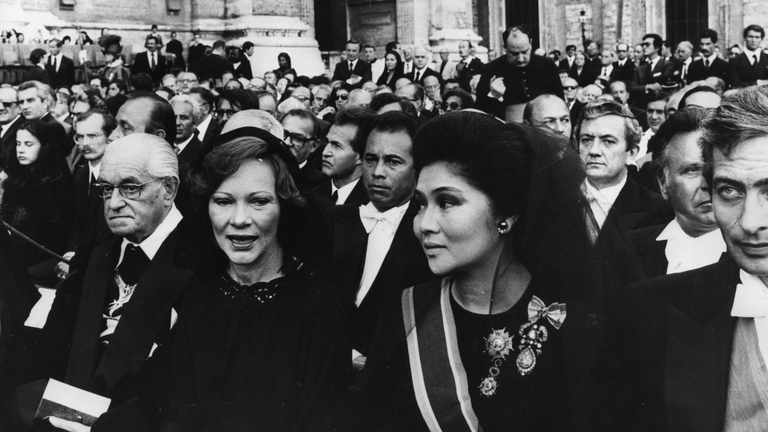
Costa Rica celebrated its first same-sex marriage when two women, Alexandra Quiros and Dunia Araya, celebrated their wedding: an “extraordinary moment”.
A tiara adorned with diamonds and precious gemstones could fund treatment of over 12,000 people affected by tuberculosis, while a sapphire and diamond necklace could provide electricity to 2,252 households in off-grid areas. In order to raise people’s awareness on corruption and abuse of power, the government of the Philippines launched a very uncommon campaign.
A tiara adorned with diamonds and precious gemstones could fund treatment of over 12,000 people affected by tuberculosis, while a sapphire and diamond necklace could provide electricity to 2,252 households in off-grid areas. In order to raise people’s awareness on corruption and abuse of power, the government of the Philippines launched a very uncommon campaign. Major national newspapers published the pictures of the jewellery once owned by the family of former dictator Ferdinand Marcos. Each piece of jewellery is accompanied by a description of how the cost could instead be turned into initiatives and services to improve citizens’ lives.
IN PHOTOS: PCGG’s virtual exhibit of recovered Marcos jewelry https://t.co/1aNeNgOnsB pic.twitter.com/Fq3EnR0unS
— GMA News (@gmanews) 29 marzo 2016
The initiative named Virtual Jewelry Exhibit, a Story of Excesses: What could have fuelled a nation’s development, launched by the Presidential Commission on Good Government (PCGG) and gone viral on Philippine social networks, aims to show new generations the excesses of the Marcoses, forced to flee the country following a popular revolution in 1986. Marcoses’ corrupted and violent governance, accused of having accumulated over 10 billion dollars in properties, jewels, money, and precious objects, made history mainly thanks to the then First Lady Imelda. Her unbridled love for luxury translated into a collection of more than 2,700 shoes, 4,000 designer dresses, and hundreds of works of art and precious gemstones: a real treasure – made legendary by a rare pink diamond worth 5 million dollars – found in the presidential palace in the aftermath of the revolution, and declared as a universal heritage in 1998.
#VirtualJewelryExhibit: A brilliant coronet part of the Hawaii Collection. More facts at https://t.co/tnbXEkyjzW pic.twitter.com/Ppqn66vSai
— PCGG (Official) (@TheNewPCGG) 16 marzo 2016
The Presidential Commission’s campaign comes just a few weeks before the elections in May that see three members of the Marcos family becoming candidates for key roles, which could bring them back to the Philippine political scene. Ferdinand Marcos Jr., known as Bongbong, is currently a senator and is running for the vice-presidency. His sister runs for becoming governor and Imelda Marcos hopes to be re-elected at the Philippine Congress. As a response to the campaign, Ferdinand Marcos accused the Commission of undermining his political career.
Imelda – the Steel Butterfly who accompanied for over 25 years the dictator who made the Philippines the most corrupted country in South Asia – faced many lawsuits after Ferdinand died in 1989. Most of them were linked to corruption, despite she always denied it. “They went into my closets looking for skeletons,” she said. “But thank God, all they found were shoes, beautiful shoes”.
Siamo anche su WhatsApp. Segui il canale ufficiale LifeGate per restare aggiornata, aggiornato sulle ultime notizie e sulle nostre attività.
![]()
Quest'opera è distribuita con Licenza Creative Commons Attribuzione - Non commerciale - Non opere derivate 4.0 Internazionale.
Costa Rica celebrated its first same-sex marriage when two women, Alexandra Quiros and Dunia Araya, celebrated their wedding: an “extraordinary moment”.
On top of a 2.4 million dollar compensation, the indigenous Ashaninka people will receive an official apology from the companies who deforested their lands in the 1980s.
Rodrigo Duterte, President of the Philippines since May 2016, recently made the headlines for having called Obama a “son of a whore” during a press conference at the Association of South East Asian Nations (ASEAN) summit in Laos. The remark, which led to the cancellation of a bilateral meeting between the two presidents, has drawn international attention to
From Italy to the United States, workers in the logistics and delivery sectors are protesting to demand better sanitary conditions to protect themselves from Covid-19.
The pandemic and its restrictions are affecting everyone, without exceptions. However factors like housing, income inequalities, gender, access to technology and working conditions are influencing how people experience the health crisis.
In the midst of India’s coronavirus lockdown, two dozen people lost their lives in a desperate bid to return home: migrant labourers forced to leave the cities where they worked once starvation began knocking at their doors.
Apple, Dell, Microsoft and Tesla are among the tech companies named in a lawsuit brought in the US by the families of children killed and maimed in cobalt mining activities in the Democratic Republic of Congo.
We, the people is Survival’s 2020 calendar, which features the winners of the photography contest showcasing images of the world’s indigenous peoples.
Un violador en tu camino – the rapist is you – is an anthem protesting the impunity of gender-based violence. It began in Chile and has become a global flash mob, bringing people to the streets and resonating all over the world.








